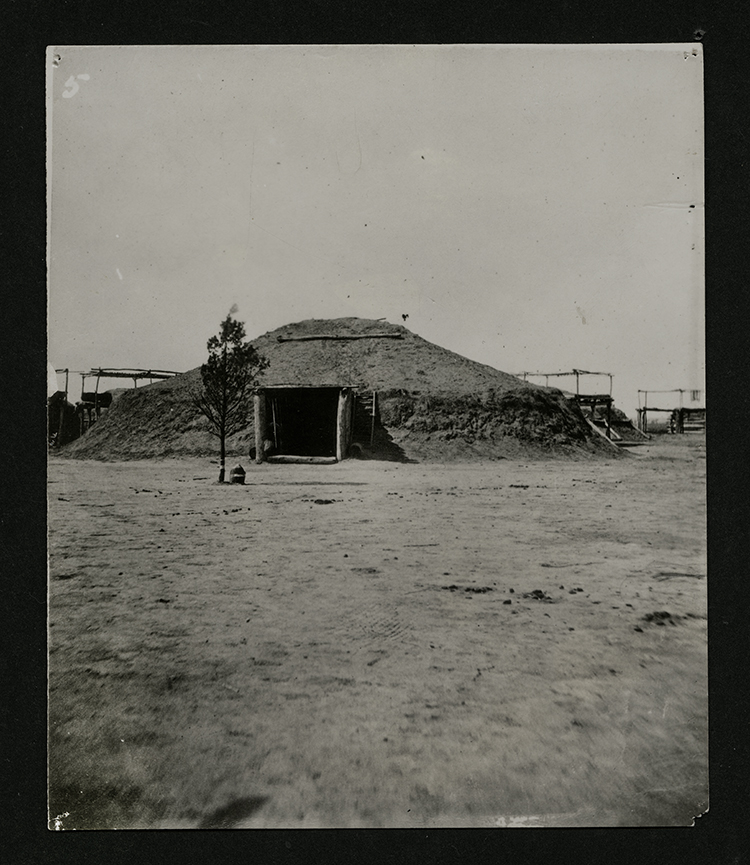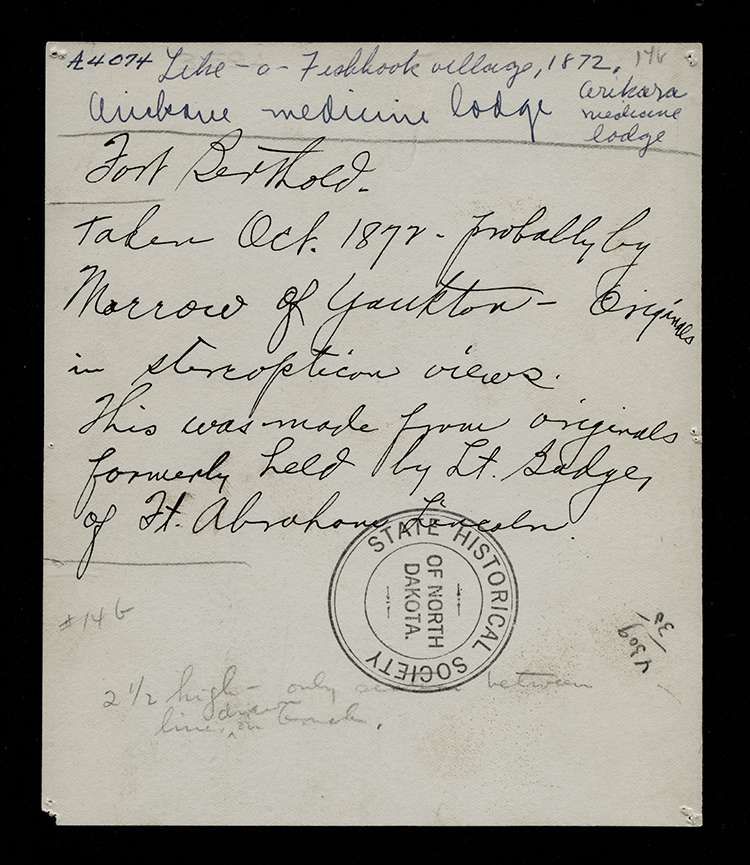Collection: A - A Collection
Folder: 0000.000
Item: 4074_00001
Title: Arikara medicine lodge, Like-a-Fishhook village
Date: 10/1872
Creator: Morrow, Stanley J.,--1843-1921
Inscription/Marks: [back of print] A4074-00001 Like-A-Fishhook Village, 1872. Arikara Medicine Lodge146. Fort Berthold. Taken Oct. 1872. probably by Morrow of Yankton--Originals in stereopticon views. This was made from originals formerly held by Lt. Badger of Ft. Abraham Lincoln. #146. State Historical Society of North Dakota. [Printing Instructions] 2 1/2 high only between lines drawn back. 4309/35. [biography]
Stanley J. Morrow was born in Richland County, Ohio, on May 3, 1843, and moved to Wisconsin early in his childhood. In 1861, he joined the 7th Wisconsin Volunteer Infantry as a drummer. Morrow was then transferred into the Veteran Reserve and was stationed at Point Lookout Prison in Maryland as an assistant to renowned Civil War photographer Matthew B. Brady. Brady instructed Morrow in photography and the wet plate process, which Morrow used throughout his career.
Upon exiting the war, Morrow married Isa Ketchum, and the couple moved to Yankton, Dakota, around 1868. Morrow established a photography gallery there and taught Isa the photographic process. When Morrow was away, Isa ran the gallery to fund his photographic expeditions.
In 1876, Stanley Morrow met soldiers returning from General George A. Crook’s expedition in pursuit of the Lakota Sioux and Cheyenne. Morrow photographed soldiers reenacting scenes from the starvation march back to the Black Hills and from the Battle of Slim Buttes, and photographed Sioux warriors captured in battle. Morrow became post photographer at Fort Keogh in 1878 and later that year opened a gallery at Fort Custer. In April 1879, while working as photographer at Fort Custer, he accompanied Captain George K. Sanderson and a company of the 11th Infantry on an expedition to Little Bighorn Battlefield to clear the field of animal bones and remark the graves of fallen soldiers.
Stanley Morrow returned to Yankton in 1880, photographing local events including the Great Flood of 1881.When Isa fell ill in 1882, the couple moved to Florida. Stanley J. Morrow died in Dallas, Texas, on December 10, 1921.
Summary: View from across dance grounds of Arikara Medicine Lodge, earthlodge with sacred pine standing in front a few yards from entrance. Behind the earth lodge are other structures with drying racks on the upper level.
Red ID: PH_I_92333 Image ID: 133854 Image Notes: A4074-00001
Collection: A - A Collection
Folder: 0000.000
Item: 4074_00001
Title: Arikara medicine lodge, Like-a-Fishhook village
Date: 10/1872
Creator: Morrow, Stanley J.,--1843-1921
Inscription/Marks: [back of print] A4074-00001 Like-A-Fishhook Village, 1872. Arikara Medicine Lodge146. Fort Berthold. Taken Oct. 1872. probably by Morrow of Yankton--Originals in stereopticon views. This was made from originals formerly held by Lt. Badger of Ft. Abraham Lincoln. #146. State Historical Society of North Dakota. [Printing Instructions] 2 1/2 high only between lines drawn back. 4309/35. [biography]
Stanley J. Morrow was born in Richland County, Ohio, on May 3, 1843, and moved to Wisconsin early in his childhood. In 1861, he joined the 7th Wisconsin Volunteer Infantry as a drummer. Morrow was then transferred into the Veteran Reserve and was stationed at Point Lookout Prison in Maryland as an assistant to renowned Civil War photographer Matthew B. Brady. Brady instructed Morrow in photography and the wet plate process, which Morrow used throughout his career.
Upon exiting the war, Morrow married Isa Ketchum, and the couple moved to Yankton, Dakota, around 1868. Morrow established a photography gallery there and taught Isa the photographic process. When Morrow was away, Isa ran the gallery to fund his photographic expeditions.
In 1876, Stanley Morrow met soldiers returning from General George A. Crook’s expedition in pursuit of the Lakota Sioux and Cheyenne. Morrow photographed soldiers reenacting scenes from the starvation march back to the Black Hills and from the Battle of Slim Buttes, and photographed Sioux warriors captured in battle. Morrow became post photographer at Fort Keogh in 1878 and later that year opened a gallery at Fort Custer. In April 1879, while working as photographer at Fort Custer, he accompanied Captain George K. Sanderson and a company of the 11th Infantry on an expedition to Little Bighorn Battlefield to clear the field of animal bones and remark the graves of fallen soldiers.
Stanley Morrow returned to Yankton in 1880, photographing local events including the Great Flood of 1881.When Isa fell ill in 1882, the couple moved to Florida. Stanley J. Morrow died in Dallas, Texas, on December 10, 1921.
Summary: View from across dance grounds of Arikara Medicine Lodge, earthlodge with sacred pine standing in front a few yards from entrance. Behind the earth lodge are other structures with drying racks on the upper level.
Red ID: PH_I_92333 Image ID: 133855 Image Notes: A4074-00001-back



